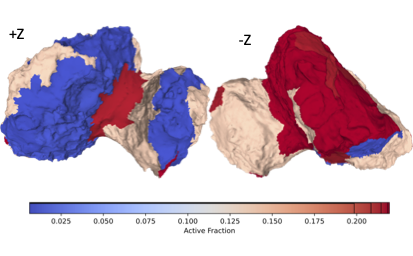Activity on different terrain types on comet 67P/Churyumov-Gerasimenko
- 1University of Stirling, Stirling, UK
- 2Aix-Marseille Université, CNRS, CNES, Laboratoire d’Astrophysique de Marseille, Marseille, France
- 3Southwest Research Institute, 1050 Walnut St, Suite 300, Boulder, CO, USA
- 4Alma Mater Studiorum - Università di Bologna, Department of Industrial Engineering, Via Fontanelle 40, I-47121 Forlì (FC), Italy
Understanding cometary activity is key to exploring their materials and surface physics, with implications for comet formation and subsequent evolution. Outgassing produces a reaction force on nuclei that can alter their trajectory and spin, allowing constraints to be placed on comet models by measuring the observed orbit and rotation changes. For comet 67P/Churyumov-Gerasimenko, detailed measurements have been made by the Rosetta spacecraft and various attempts have been made to model the activity (see, e.g. [1,2]).
Here we will present ongoing work, testing various activity distributions in an effort to fit Rosetta outgassing, trajectory, and rotation data using the activity model of [2]. We test a number of different activity distributions over the surface of the comet by varying the Effective Active Fraction (EAF), relative to pure water ice, of facets on a shape model. We investigate different spatial patterns in EAF, and attempt to correlate them to physical features on the cometary surface. Here we are able to achieve a good fit to the Rosetta data by parameterizing EAF in terms of the different geological unit types on 67P (Fig. 1). This will have important implications for understanding how activity works on the different types of surface observed on cometary nuclei, including ‘rough’, ‘smooth’, ‘dusty’ and ‘rocky’ surface morphologies.. The objective here is to constrain the shape of the activity curve on these various surfaces that a more detailed thermal model (see, for example [3,4]) must produce in order to fit the data.
In addition to the changes in rotation period examined in [2], we also compute changes in the rotation axis, using a method based on [5] in order to compare with the observations. This provides an additional constraint on the spatial distribution of activity. Finally, we also compare the trajectory information, in the form of Earth-to-comet range, with the new analysis of Rosetta radio-tracking data performed in [6].

Fig. 1. Peak Effective Active Fraction over the surface of 67P for a model fit to geological unit types.
References
- Nongravitational Effects of Cometary Activity. S. Mottola, N. Attree, L. Jorda, H.U. Keller, R. Kokotanekova, D. Marshall. Space Science Reviews 216 (1), 1-20
- Constraining models of activity on comet 67P/Churyumov-Gerasimenko with Rosetta trajectory, rotation, and water production measurements. N. Attree, L. Jorda, O. Groussin, S. Mottola, N. Thomas, Y. Brouet, E. Kührt. Astronomy & Astrophysics 630, A18
- On the activity of comets: understanding the gas and dust emission from comet 67/Churyumov-Gerasimenko’s south-pole region during perihelion. B. Gundlach, M. Fulle, J. Blum. Monthly Notices of the Royal Astronomical Society, Volume 493, Issue 3, April 2020, Pages 3690–3715
- Near-perihelion activity of comet 67P/Churyumov–Gerasimenko. A first attempt of non-static analysis. Yu. Skorov, H. U. Keller, S. Mottola and P. Hartogh. Monthly Notices of the Royal Astronomical Society, Volume 494, Issue 3, May 2020, Pages 3310–3316
- Kramer, T., Laeuter, M., Hviid, S., et al. 2019. A&A, Volume 630, id.A3, 11 pp.
- Lasagni Manghi R., Zannoni M., Tortora P., Kueppers M., O'Rourke L., Martin P., Mottola S., et al., 2020, EGU General Assembly 2020, Online, 4–8 May 2020, EGU2020-19173
How to cite: Attree, N., Jorda, L., Groussin, O., Marschall, R., Lasagni Manghi, R., Tortora, P., and Zannoni, M.: Activity on different terrain types on comet 67P/Churyumov-Gerasimenko, Europlanet Science Congress 2021, online, 13–24 Sep 2021, EPSC2021-17, https://doi.org/10.5194/epsc2021-17, 2021.

